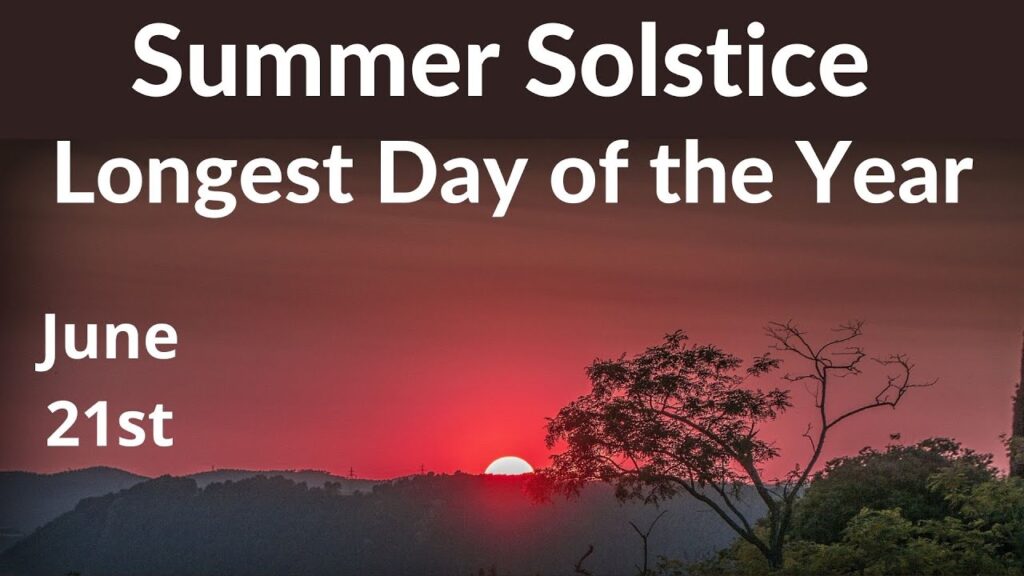Weather
Summer Solstice 2021 : The Longest Day of The Year

The West is boiling, and the East is hot, as well, with perfect timing for the Summer solstice 2021. Sunday denotes our longest day and most limited evening of the year and the primary “official” day of summer in the Northern Hemisphere.
The current year’s solstice rides two schedule days, showing up at 11:32 p.m. Eastern time on June 20. In North America, Sunday will bring the most light, while in Europe and Asia, Monday will actually be the longest day of the year, however by a couple of moments.
What occurs on the solstice?
People from the beginning of time have commended the Summer solstice with ceremonies like huge fires and stately moves to check the entry of the seasons.
On the June solstice, the sun’s upward beams strike the Tropic of Cancer, a line of scope 23.5 degrees north of the equator. Topographically talking, it’s the northernmost point where the sun shows up straight overhead (90 degrees over the skyline) the entire year. In the Northern Hemisphere, sunshine arrives at its yearly pinnacle, and the sun takes its longest and most elevated way through the sky.

(National Weather Service)
The explanation we have solstices, and seasons, is on the grounds that Earth doesn’t circle the sun totally upstanding. All things considered, our planet is shifted on its hub by about 23.5 degrees, which implies one half of the globe gets a greater amount of the daylight and energy at various seasons.
On the June solstice, the Northern Hemisphere inclines most toward the sun, giving us longer days and more extraordinary daylight. It’s the inverse in the Southern Hemisphere, where June 21 denotes the beginning of winter and the most brief day of the year.
Light hours on the solstice
In the Northern Hemisphere, the length of day relies upon how far you live from the equator. In Washington, the sun is awake for 14 hours and 54 minutes on June 20, ascending at 5:42 a.m. also, setting at 8:36 p.m.
Areas to our north see considerably more sunshine. New York, Boston and Chicago all see more than 15 hours of light on the solstice, while in Seattle, the sun is up barely short of 16 hours.

(Brian Brettschneider)
The guide above, made by climatologist Brian Brettschneider, delineates how much sunlight changes across the Northern Hemisphere. Every red circle is a particular line of scope and addresses a 30-minute increment or lessening in sunlight. Urban communities associated by a similar line have similar number of sunshine hours. For instance, London and Paris both see over 16 hours of light on June 21 — more than the vast majority of the adjacent United States.
Northernmost dawn and nightfall
“Solstice” comes from the Latin word solstitium, which signifies “sun stopping.” On the June solstice, the sun’s day by day toward the north development in the sky seems to interruption, and we see the sun rise and set at its northernmost focuses not too far off. After the solstice, the situation of dawn and dusk gradually start to move toward the south once more.
Our northern-arranged dawns and nightfalls mean the sun takes a lofty move through the sky. In Washington, the sun climbs 74.5 degrees over the skyline at sunlight based early afternoon (1:09 p.m.) on the solstice, the most noteworthy it gets the entire year.
You’ll see evidence of the sun’s intensity just by looking at your shadow. As the sun appears nearly overhead, your midday shadow on the summer solstice will be the shortest of the year.
Earliest Sunrise and Latest Sunset Not on the Summer Solstice
While the summer solstice has the longest day length, it’s anything but when we see our soonest dawn or most recent dusk. In Washington, the soonest dawn (5:42 a.m., determined definitely to the second) happened June 14, as per timeanddate.com. In the mean time, our most recent dusk (8:37 p.m.) isn’t until June 27. We can say thanks to Earth’s slant and our circular circle around the sun for this cosmic misalignment.
The guides underneath show the nearby time and date of the soonest dawn and most recent dusk in North America. Red lines show the date of the soonest dawn or most recent nightfall, while the concealed tones compare to dawn and dusk times. Notice how the dates of the most punctual dawn and most recent nightfall nearly concur with the solstice close to the Arctic Circle, while in lower scopes (Florida and Texas, for instance) the soonest dawn and most recent dusk happen over about fourteen days separated.
The interwoven of shadings shows what both time regions and scope mean for neighborhood dawn and dusk times. In Maine, the soonest dawn happens before 5 a.m., while in southwestern Texas, the sun doesn’t ascend until after 6:30 a.m.
Numerous pieces of the nation see their most recent dusk after 8:30 p.m. soon after the solstice, and in certain spaces — including the northern level and the western locales of each time region — the sun sets after 9 p.m.
The greater part of Alaska sees its most recent nightfall around 12 PM, that is, if the sun even sets by any means. In regions along and north of the Arctic Circle, the sun ceaselessly circles through the sky the entire day, and it never gets dull.
Most Smoking Days Ordinarily After the Summer Solstice
After the solstice, we gradually begin to lose sunlight. Washington will lose a couple of moments every day over the coming week. Beginning July 10, we will shave off an entire moment of sunshine as time passes.
All things considered, don’t show up until mid-July. This postponement, or occasional slack, happens in light of the fact that the measure of sun based energy showing up at the ground keeps on dominating the sum leaving the Northern Hemisphere for half a month after the solstice. It’s to a great extent driven by the seas, which take any longer than land to heat up and cool down, and delivery heat gradually over the long run.
While a significant part of the western United States is encountering an uncommon warmth wave and serious dry season, summer in the eastern portion of the nation has so far been generally agreeable. Whatever the remainder of summer brings, one thing is sure: These long, splendid days will in the end subside as we turn the corner toward fall.
SOURCE : washingtonpost
For More Trending News , Visit Here : https://www.chiangraitimes.com/trending-news/































